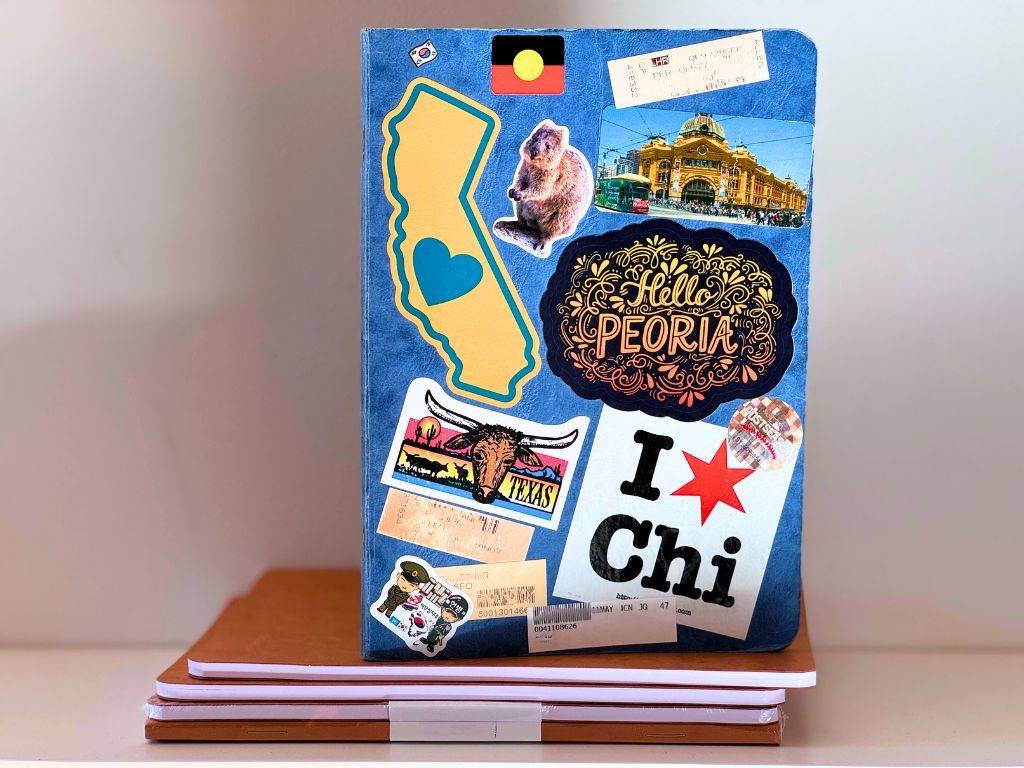Stickers and scribbles: the joy of keeping a travel diary
In 2016, I started writing a travel diary.
I’d been travelling for decades by then, of course. There were plenty of photos in different formats — childhood Polaroids, obsolete digital cameras, iPhone snaps. All of them captured a moment in time, a snapshot of what a place looked like, but rarely how it felt.
There’s something different about flipping back through the pages of a travel diary. A faded receipt tucked between entries. A quick scrawl of something overheard on the streets of Shoreditch, or the sting of Copenhagen’s winter wind as industrial music seemed to rise from the streets. It’s the closest thing I have to a memory upload.
Now, as I’m ready to crack the spine on a new volume, I find myself leafing through the previous one. There’s the tonal disconnect of watching a Cadillac idle outside the former Texas Book Depository in Dallas. The smiling irony of Sweet Home Chicago playing on shuffle as we drove into the Windy City. The man who timed his beers with absolute precision on the train between Zurich and Munich. The sheer, adorable delight of seeing my first quokka on Rottnest Island.
Volume 1 of my travel diary, layered with stickers from hostels, museums and beer labels.
It’s more than a logbook
Part of keeping a travel diary is about memory. After all, there are times when it simply isn’t appropriate to take a photo. Sure, it’s useful for recalling the name of that bakery you visited, but there are pages of my battered blue book that are just long lists. Only a few entries later, though, there’s a note about someone’s T-shirt in Antwerp that read No one likes us. We don’t care. (I doubt he was about to pose for a snap). Or the silly road-trip joke where we kept calling Amsterdam’s Muiderpoort “Murder Port.”
(Sidebar: Muiderpoort is actually a lovely stop if you want to escape the crowds of Amsterdam Central — plus there’s Brouwerij 't IJ and the cosy Poesiat & Kater).
Sometimes I ended up writing about my dreams, or even questioning the worth of my writing. In those moments, the diary became a mood book — a grab bag of emotions carried through long stretches away from home. Now, when I read back, I’ll catch myself smiling as that rainy day comes flooding back.
The small things that stay with you
It also became a place to keep all the ephemera (spot the librarian term!) collected along the way. As passport stamps grow increasingly rare, I began to fill my notebooks with stickers, ticket stubs, and regional stamps.
In Korea, the cultural villages and museums had their own stamp stations. On a cruise to Eden, I stamped my book at the visitor centre. Throughout Japan’s train stations you’ll find eki stamps, and similar versions appear in temples or other tourist hubs.
I’ve seen great examples online of people sticking Instax photos directly into their diary as a snapshot of the day — something I’d love to start doing in Volume 2 if it wasn’t another thing to carry around. For now, I plaster the covers (and sometimes the inside once I run out of space) with stickers I pick up along the way. Some are serendipitous: a daily visitor sticker from a Copenhagen museum, a Belgian beer label. Other times, I’m happily joining the souvenir crowd at the gift shop.
Looking back
As a writer, flipping through old entries is a bit like looking at baby photos: there’s as much to cringe over as there is to celebrate. But it all points to who I was at the time I visited a place.
When I first started, I tried to make ‘profound’ statements about a chef who “blitzed about the kitchen with a display of speed and grace that was only matched by the gorgeous meals on display.” More recently, my language has become far more economical — “Food is amazing: vegan delights of a traditional bibimbap or bulgogi at Osegye Hyang.” I tend to lean into observations of other humans now, definitely a habit shaped by the post-pandemic era. There are a few pages dedicated to the strange atmosphere of a hotel in Australia’s Blue Mountains, and another half-page chronicling the rising frustration of some people in an airport lounge who absolutely did not like someone named Jeff.
Tips for getting started
Find a notebook you like.
Old battered favourite? A crisp new Moleskin? It doesn’t matter. I use an unlined A5 notebook so I have space for pictures, stickers and the odd sketch.
Just write
You don’t have to be beautiful prose. It doesn’t have to be insightful. Just start writing about what you see and hear. It’s for you.
Make it a ritual, not a chore.
Five minutes at the end of the day is enough. Some days you’ll write a lot, others hardly anything. That’s fine.
Include the rough days.
No holiday is perfect. Some days just go wrong. It’s not your picture-perfect Insta feed. Sometimes, the bad days make the best stories.
Stick in the scraps
Collecting postcards? Stickers? Put them in the book. Make your own stylish passport.
Gaps are ok.
You don’t have to do it every day. You’re allowed to ‘fall behind.’ You are on holiday. Enjoy it.



